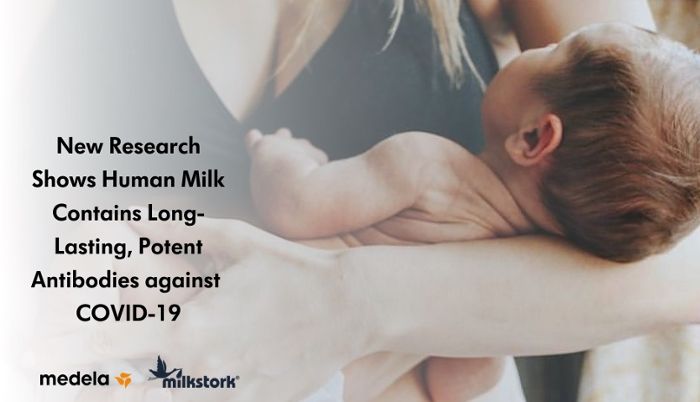Is breastfeeding still important after you’ve reached the six-month milestone? And how long should you continue? The answers may surprise you, as the additional health and developmental benefits of breastfeeding – which solid foods and other milks cannot offer – are often overlooked.
How long should I breastfeed for?
The World Health Organization (WHO) recommends breastfeeding for two years and beyond – and this applies to families around the world, not just in developing countries.1
“It’s important to note the WHO doesn’t set a maximum breastfeeding duration,”2 says Dr Leon Mitoulas, Medela’s Head of Breastfeeding Research. “From an anthropological perspective, breastfeeding for between two-and-a-half and seven years would be optimal.3 However, cultural norms today generally entail weaning at a much younger age.”
The WHO’s recommendations are supported by a recent surge in research into the first 1,000 days of a child’s life – from conception to the second birthday.4 Dr Mitoulas explains: “Scientists have discovered the right nutrition, and other factors, have the most profound impact on growth and long-term health during this time. Evidence unequivocally demonstrates that breastfeeding is uniquely beneficial during that crucial 1,000-day window.
“Breastfeeding can be considered a food, a medicine and a signal all at the same time,”5 he adds. “And these trifold benefits certainly continue beyond two years.”
Food: Nutritional benefits of extended breastfeeding
Once your baby starts eating solids at around six months, you might think your breast milk becomes just a ‘drink’ that complements them. In fact, the opposite is true – your baby will only get a tiny proportion of his calories and nutrients from food when he first starts solids.
“The undisputed best start for babies is exclusive breastfeeding for the first six months. But even after your baby starts eating complementary foods, breast milk provides significant nutrition,” says Dr Mitoulas.
When exclusively breastfeeding, a baby typically consumes 750 to 800 ml (26.4 to 28 fl oz) of milk each day. At nine to 12 months old, he could still take around 500 ml (17.6 fl oz) a day, which provides about half his daily calories. By 18 months, he’ll probably have about 200 ml (7 fl oz) a day, which is about 29% of his calories.6
It’s true that after six months your baby needs other foods for nutrients that he may not get from your breast milk or his own reserves, including iron, zinc and vitamins B and D.1,7 But even in his second year of life, breast milk provides significant amounts of other key nutrients, as Dr Mitoulas explains:
“At this stage, breast milk provides about 43% of a baby’s protein, 60% of his vitamin C, 75% of his vitamin A, 76% of his folate, and 94% of his vitamin B12.”8
Medicine: Health benefits of breastfeeding after six months
Whilst the message to promote exclusive breastfeeding for six months is well known, there is not much information on the role of breastfeeding and human milk beyond six months, once complementary foods have been introduced to an infant’s diet. This is despite organisations such as the WHO recommending the provision of human milk beyond six months.1
Continuing to breastfeed after six months has been shown to lower the chances of some childhood and adult illnesses and, if your baby does get ill, helps him recover more quickly.
Breastfeeding protects your baby from infection and illness, so much so that it’s even considered a form of ‘personalised medicine’, with potential lifelong effects,” says Dr Mitoulas.
For example, breastfeeding for longer than six months has been shown to protect your baby against certain childhood cancers, such as acute lymphocytic leukaemia and Hodgkin’s lymphoma.9 Breastfeeding might also lessen his chances of developing type 2 diabetes,10 although this effect is confounded, or attenuated by factors such as smoking, gestational weight gain, preterm birth and other factors. There are also benefits for your baby in terms of sight 11 , dental problems,12 and obesity.”13
Your breast milk can also reduce your baby’s risk of diarrhoea and sickness,14gastroenteritis, colds and flu, thrush and ear, throat and lung infections.9,15This is especially helpful as he gets older and starts interacting with other children or going into childcare, where germs can be rife.
Breastfeeding can also be a lifesaver, as Dr Mitoulas points out: “The consequences of not breastfeeding between six and 23 months can be dire in low- and middle-income countries, where babies who aren’t breastfed are twice as likely to die from infection as babies who are breastfed, even partly.”16 And breastfeeding is not just about the benefits of your milk, it’s also wonderful for nurturing and calming your baby. Nothing soothes an upset infant or toddler like a nursing session with mum. As your baby grows, a feed helps with everything from teething and vaccinations to the inevitable knocks and scrapes or viruses that occur along the way. For many mums, breastfeeding can feel like a miracle worker.
Signal: Enhanced benefits
The act of being close to your baby, instantly responding to his needs and engaging in lots of eye contact also sends signals between you. Scientists think these could affect many aspects of your child’s development, from appetite to academic performance. The longer you breastfeed, the stronger the positive outcome is likely to be.
Breast milk contains thousands of active molecules,” Dr Mitoulas explains. “These range from enzymes that help digest fats17 and hormones that regulate appetite,18 to immune molecules that promote immune system development.19
Did you know that breast milk is actually alive? Every day your baby drinks millions to billions of living cells20 – there are thousands of them in each millilitre of your milk, including stem cells,”21 he continues. “Each one of these cells has a specific job in terms of keeping your baby healthy, and research is ongoing to discover exactly how these components benefit an infant during long-term breastfeeding.”
One thing that’s already known is that extended breastfeeding has a positive impact on a child’s IQ. Studies show a consistent three-point IQ advantage for children who were breastfed over those who were never breastfed.22
Breastfeeding beyond six months has even been linked to fewer behavioural problems in school-age children23 and improved mental health in children and adolescents.24
Shouldn’t I switch to follow-on formula after six months?
The health claims on the packaging may look impressive, but there is no better milk for your baby than your own.
No formula milk contains all the antibodies, live cells, growth factors, hormones or helpful bacteria, nor the array of enzymes, amino acids and micronutrients found in breast milk.25 Your milk adjusts to provide your baby with more infection-fighting antibodies and white blood cells when he’s ill26 – something formula simply can’t do. Read Breast milk vs formula: How similar are they? for more information.
Breastfeeding after six months: Benefits for mums
Extended breastfeeding isn’t just brilliant for your baby – it’s also great for you. By continuing breastfeeding beyond six months, you lower your lifelong risk of developing heart disease,27 type 2 diabetes28 and cancers of the breast,29 ovaries30 and uterus.”31 And breastfeeding mums often find their periods don’t return for many months – and possibly for as long as two years.32
“The desire to get back to their pre-pregnancy body weight is a significant one for many mums,” says Dr Mitoulas. “One study showed that a mother’s body mass index (BMI) is 1% lower for every six months of breastfeeding.”24
Not to mention that after six months, breastfeeding is very convenient. Your breasts produce the right amount of milk when they need to and you don’t have to clean equipment or take anything with you when going out. You may also find you’re increasingly only feeding at times that fit your routine, such as before work, after childcare pick-up, and at bedtime. And even if you’re back at work, you can use a breast pump to express milk for your baby so he can continue enjoying the advantages.
With so many potential benefits, it’s perhaps not surprising a growing number of mums are choosing to practise ‘natural-term’ or ‘full-term’ breastfeedingand letting their child decide the right time to stop.
1 World Health Organization. Health topics: Breastfeeding [Internet]. Geneva, Switzerland: WHO; 2018 [Accessed: 26.03.2018]. Available from: http://www.who.int/topics/breastfeeding/en/
2 Innocenti Research Centre. 1990–2005 Celebrating the Innocenti Declaration on the protection, promotion and support of breastfeeding: past achievements, present challenges and the way forward for infant and young child feeding. Florence: United Nations Children’s Fund; 2005. 38 p.
3 Dettwyler KA. When to wean: biological versus cultural perspectives. Clin Obstet Gyecol. 2004;47(3):712-723.
4 1,000 Days. [Internet] Washington DC, USA; 2018. Available from:
Home
5 TED. TEDWomen: What we don’t know about mother’s milk [Internet]. New York, NY, USA: TED Conferences LLC; 2016. [Accessed 26.03.2018]. Available from www.ted.com/talks/katie_hinde_what_we_don_t_know_about_mother_s_milk/reading-list
6 Kent JC et al. Breast volume and milk production during extended lactation in women. Exp Physiol. 1999;84(2):435-447.
7 Kuo AA et al. Introduction of solid food to young infants. Matern Child Health J. 2011;15(8):1185-1194.
8 Dewey, KG. Nutrition, growth, and complementary feeding of the breastfed infant. Pediatr Clin North Am. 2001;48(1):87-104.
9 Bener A et al. Does prolonged breastfeeding reduce the risk for childhood leukemia and lymphomas? Minerva Pediatr. 2008;60(2):155-161.
10 Bjerregaard LG et al. Breastfeeding duration in infancy and adult risks of type 2 diabetes in a high‐income country . Matern Child Nutr. 2019;e12869.
11 Singhal A et al. Infant nutrition and stereoacuity at age 4–6 y. Am J Clin Nutr. 2007;85(1):152-159.
12 Peres KG et al. Effect of breastfeeding on malocclusions: a systematic review and meta‐analysis. Acta Paediatr. 2015;104(S467):54-61.
13 Horta BL et al. Long‐term consequences of breastfeeding on cholesterol, obesity, systolic blood pressure and type 2 diabetes: a systematic review and meta‐analysis. Acta Paediatr. 2015;104(S467):30-37.
14 Howie PW et al. Protective effect of breast feeding against infection. BMJ. 1990;300(6716):11-16.
15 Ladomenou F et al. Protective effect of exclusive breastfeeding against infections during infancy: a prospective study. Arch Dis Child. 2010;95(12):1004-1008.
16 Sankar MJ et al. Optimal breastfeeding practices and infant and child mortality: a systematic review and meta‐analysis. Acta paediatr. 2015;104(S467):3-13.
17 Lönnerdal B. Bioactive proteins in breast milk. J Paediatr Child Health. 2013;49(S1):1-7.
18 Gridneva Z et al. Effect of human milk appetite hormones, macronutrients, and infant characteristics on gastric emptying and breastfeeding patterns of term fully breastfed infants. Nutrients. 2016;9(1):15.
19 Field CJ. The immunological components of human milk and their effect on immune development in infants. J Nutr. 2005;135(1):1-4.
20 Hassiotou F, Hartmann PE. At the dawn of a new discovery: the potential of breast milk stem cells. Adv Nutr. 2014;5(6):770-778.
21 Cregan MD et al. Identification of nestin-positive putative mammary stem cells in human breastmilk. Cell Tissue Res. 2007;329(1):129-136.
22 Victora CG et al. Breastfeeding in the 21st century: epidemiology, mechanisms, and lifelong effect. Lancet. 2016;387(10017):475-490.
23 Heikkilä K et al. Breast feeding and child behaviour in the Millennium Cohort Study. Arch Dis Child. 2011;96(7):635-642.
24 Oddy WH et al. The long-term effects of breastfeeding on child and adolescent mental health: a pregnancy cohort study followed for 14 years. J Pediatr. 2010;156(4):568-574.
25 Ballard O, Morrow AL. Human milk composition: nutrients and bioactive factors. Pediatr Clin North Am. 2013;60(1):49-74.
26 Hassiotou F et al. Maternal and infant infections stimulate a rapid leukocyte response in breastmilk. Clin Transl Immunology. 2013;2(4):e3.
27 Peters SA et al. Breastfeeding and the risk of maternal cardiovascular disease: a prospective study of 300 000 Chinese women. J Am Heart Assoc. 2017;6(6):e006081.
28 Horta BL et al. Long‐term consequences of breastfeeding on cholesterol, obesity, systolic blood pressure and type 2 diabetes: a systematic review and meta‐analysis. Acta Paediatr. 2015;104(S467):30-37.
29 Collaborative Group on Hormonal Factors in Breast Cancer. Breast cancer and breastfeeding: collaborative reanalysis of individual data from 47 epidemiological studies in 30 countries, including 50 302 women with breast cancer and 96 973 women without the disease. Lancet. 2002;360(9328):187-195.
30 Li DP et al. Breastfeeding and ovarian cancer risk: a systematic review and meta-analysis of 40 epidemiological studies. Asian Pac J Cancer Prev. 2014;15(12):4829-4837.
31 Jordan SJ et al. Breastfeeding and endometrial cancer risk: an analysis from the epidemiology of endometrial cancer consortium. Obstet Gynecol. 2017;129(6):1059-1067.
32 Howie PW. Breastfeeding: a natural method for child spacing. Am J Obstet Gynecol. 1991;165(6):1990-1991.






















